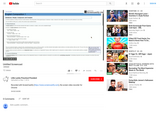
Using screetastify to give a brief lesson on simple senteces, with an embeded quiz.
- Subject:
- English Language Arts
- Material Type:
- Lesson
- Provider:
- Michigan Virtual
- Author:
- Wendy Rigley
- Date Added:
- 05/16/2016

Using screetastify to give a brief lesson on simple senteces, with an embeded quiz.
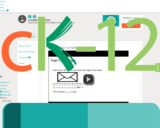
Measurement video reviewing measurement and subtraction
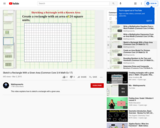
This video explains how to sketch a rectangle with a given area.
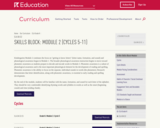
Kindergarten Module 2 continues the focus on "getting to know letters" (letter name, formation, and sound) and phonological awareness begun in Module 1. The broader phonological awareness instruction begins to move toward phonemic awareness as students prepare to decode and encode words in Module 3. Phonemic awareness is a subset of phonological awareness and is the most important phonological element for the development of reading and spelling. Phonemic awareness is the ability to focus on the separate, individual sounds in words (the phonemes). Research demonstrates that letter identification, along with phonemic awareness, is essential to early reading and spelling development.
By the end of the module, students will be familiar with the name, formation, and sound for each letter of the alphabet. They should be very comfortable identifying rhyming words and syllables in words as well as the onset (beginning sound) and rime (ending chunk).

In Grade 2, Module 2, students move beyond review of Grade 1 spelling patterns and skills. Now familiar instructional practices serve as a vehicle for introducing new spelling patterns, affixes, high-frequency words (regularly and irregularly spelled, including contractions), and fluency practice.
Students engage in deep word analysis, learning spelling rules to help them generalize spelling patterns for vowel teams and affixes, but also learning that there are many words in English for which no rules apply (example: words like "turn," "her," and "bird," which all have the /er/ sound but are all spelled with different vowels). Students begin to understand that they must learn these types of words through repeated readings and spellings and continue to commit them to memory, also relying on context when a word is read in connected text.
By the end of Module 2, students should be able apply learned spelling patterns such as "oi," "oy," "ou," and "ow" to decoding and encoding words. Students will also be able to read, spell, and understand contractions using "am," "is," "not," "would," and "have." Students will continue to decode and encode words with common prefixes ("re-," "un-," "pre-") and suffixes ("-ed," "-ing," "-er"), beginning to tackle words with both. Students will be introduced and should be able to decode words containing word endings such as "-tion" and "-sion." Lastly, students will continue to work on and reflect on their growing ability to fluently read second-grade

Kindergarten Module 3 signals an important shift: Students apply growing phonemic awareness to decoding and encoding single-syllable, CVC (consonant-vowel-consonant) words. As a result, the cycles begin to look more like the cycles in first grade, including new instructional practices such as Chaining and the Decodable Reader.
Each cycle focuses on a particular medial short vowel sound. Students work toward mastery of decoding and encoding VC (vowel-consonant) and CVC words with the focus vowel before moving on to the next. As a result, students are exposed to a growing number of words and become progressively more comfortable with analyzing words.
Phonemic awareness instruction, particularly segmentation and blending, work in tandem to support encoding and decoding. Students work on these skills during the Phonemic Blending and Segmentation and Chaining instructional practices. In each case, changes are practiced with a succession of words and sounds.
Finally, with the introduction of the Decodable Readers in whole group and the Decodable Student Reader routine in differentiated small groups, students gradually begin to take on more responsibility and independence with text. High-frequency words, introduced during the continued Mystery Word instructional practice, are used in both the shared and the decodable text.
By the end of the module, students should be able to hear and segment the individual phonemes of single-syllable spoken words. They will become increasingly more comfortable with decoding and encoding single-syllable VC and CVC words, including words with digraphs at the beginning or end.
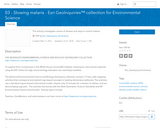
This activity investigates causes of disease and ways to control malaria.
GeoInquiries are designed to be fast and easy-to-use instructional resources that incorporate advanced web mapping technology. Each 15-minute activity in a collection is intended to be presented by the instructor from a single computer/projector classroom arrangement. No installation, fees, or logins are necessary to use these materials and software.

Students will explore social issues that plague our society and the world to find an issue they are passionate about or are interested in learning more about.Through a process of questioning, students will develop research questions that they will seek the answers to by conducting research of a variety of sources both in print and digital.Students will create a blog site to share their research findings and write 8 blog posts, each focusing on answering a different question or aspect of their social issue, using evidence from credible sources. Their blogs will be published and shared with an authentic audience.
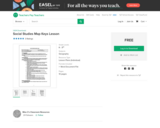
This basic social studies lesson regarding map keys is most appropriate for kindergarten through third grade students with minimal modification needed, if any at all, but could be adjusted for any grade. The lesson targets three principal objectives: students will be able to identify and interpret the key of a map as well as the explicit symbols it defines, students will be able to practice reading the explicit symbols on a map using a key to define them, as well as students will be able to design a map with the explicit symbols defined in a key. The lesson reflects gradual release and focuses on interactive activities that directly involve students in their learning.

¡Aprende las preposiciones (sobre, debajo, al lado, arriba y alrededor) mientras cantas rancheras con Sofía y Sr. Perico!
Los espectadores cantan y bailan junto con Sofía mientras aprenden las preposiciones demostradas po Sr. Perico: sobre el sombrero, debajo del sombrero, al lado del sombrero, arriba del sombrero y alrededor del sombrero.
Objetivo de Aprendizaje:
Entender y usar las siguientes partes del habla en el contexto de leer, escribir y hablar (con ayuda de un adulto): preposiciones y frases preposicionales simples de manera apropiada al hablar o escribir (por ejemplo: en, sobre, debajo, arriba).
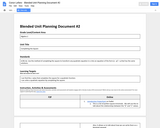
This lesson examines the process of completing the square as a method of solving quadratic equations.

Welcome to Spanish Grammar in Context, where you will find detailed grammar explanations of the Spanish language. Unlike traditional reference grammars, each topic is explained using authentic video examples from the Spanish in Texas project. Accompanying practice quizzes are available on an open Canvas course site.
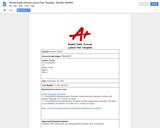
Students practice vocabulary and TPRS story using quizlet and recap.
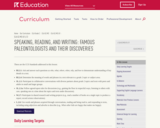
This lesson serves as the culmination lesson for the work of Unit 1. In this lesson, students have the opportunity to share their paragraph writing from the paleontologist's notebook with a classmate. Sharing and celebrating work not only supports students' speaking and listening skills, but also cultivates a sense of pride and ownership in the work.
During Work Time A, students co-create the Famous Paleontologists anchor chart by gathering information from the focused read-aloud of the excerpt from Curious about Fossils by Kate Waters. As students independently write a paragraph during Work Time B, this resource supports their writing.
During the Closing, students reflect on both their learning and work habits as they consider the Unit 1 guiding questions and habit of character of perseverance.
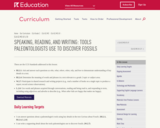
This lesson shifts the focus of this unit from reading literature to reading informational texts. As students continue to explore the topic of fossils and paleontologists, they begin to study paleontologists and their tools using excerpts from the text Curious about Fossils. This work builds on the study of real-life paleontologist Mary Anning in Lessons 2-7.
The pages of Curious about Fossils by Kate Waters are not numbered. For instructional purposes, the page that begins with "Can you see a shape ..." should be considered page 1 and all pages thereafter numbered accordingly.
During Work Time B, students begin to co-create the Tools Paleontologists Use anchor chart using information gathered from an excerpt of the text. This anchor chart will serve as a resource for students as they discuss and write about the work that paleontologists do.
During Work Time B, students are also introduced to the Paleontologist's notebook, a resource in which they will record information about paleontologists. Consider providing an opportunity for students to illustrate the cover when time permits.
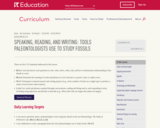
As in Lesson 10, students continue to learn about paleontologists and the work they do. Students participate in a focused read-aloud of the text Paleontology: The Study of Prehistoric Life by Susan H. Gray during Work Time A. Students then continue to co-create the Tools Paleontologists Use anchor chart as a resource for their writing during Work Time B.
Similar to Lesson 10, students collaborate to write a paragraph about the tools paleontologists use to study fossils during Work Time B.

This is a special education reading intervention lesson plan using the Fountas and Pinnell program LLI. Brain based strategies as well as special education strategies are incorporated into this lesson. This is from the green kit and is lesson 80, which is level G.
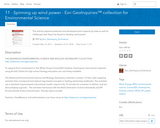
This activity explores potential and developed wind capacity by state as well as challenges that Texas has faced to develop wind power.
GeoInquiries are designed to be fast and easy-to-use instructional resources that incorporate advanced web mapping technology. Each 15-minute activity in a collection is intended to be presented by the instructor from a single computer/projector classroom arrangement. No installation, fees, or logins are necessary to use these materials and software.
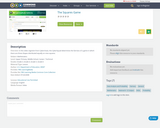
In this video segment from Cyberchase, the CyberSquad determines the fairness of a game in which there are three shapes distributed equally on nine squares.
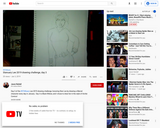
Day 3 of the #STANuary Lee 2019 drawing challenge, honoring Stan Lee by drawing a Marvel character every day in January. Day 3 is Black Widow, and I chose to draw her in the style of Archie Comics.